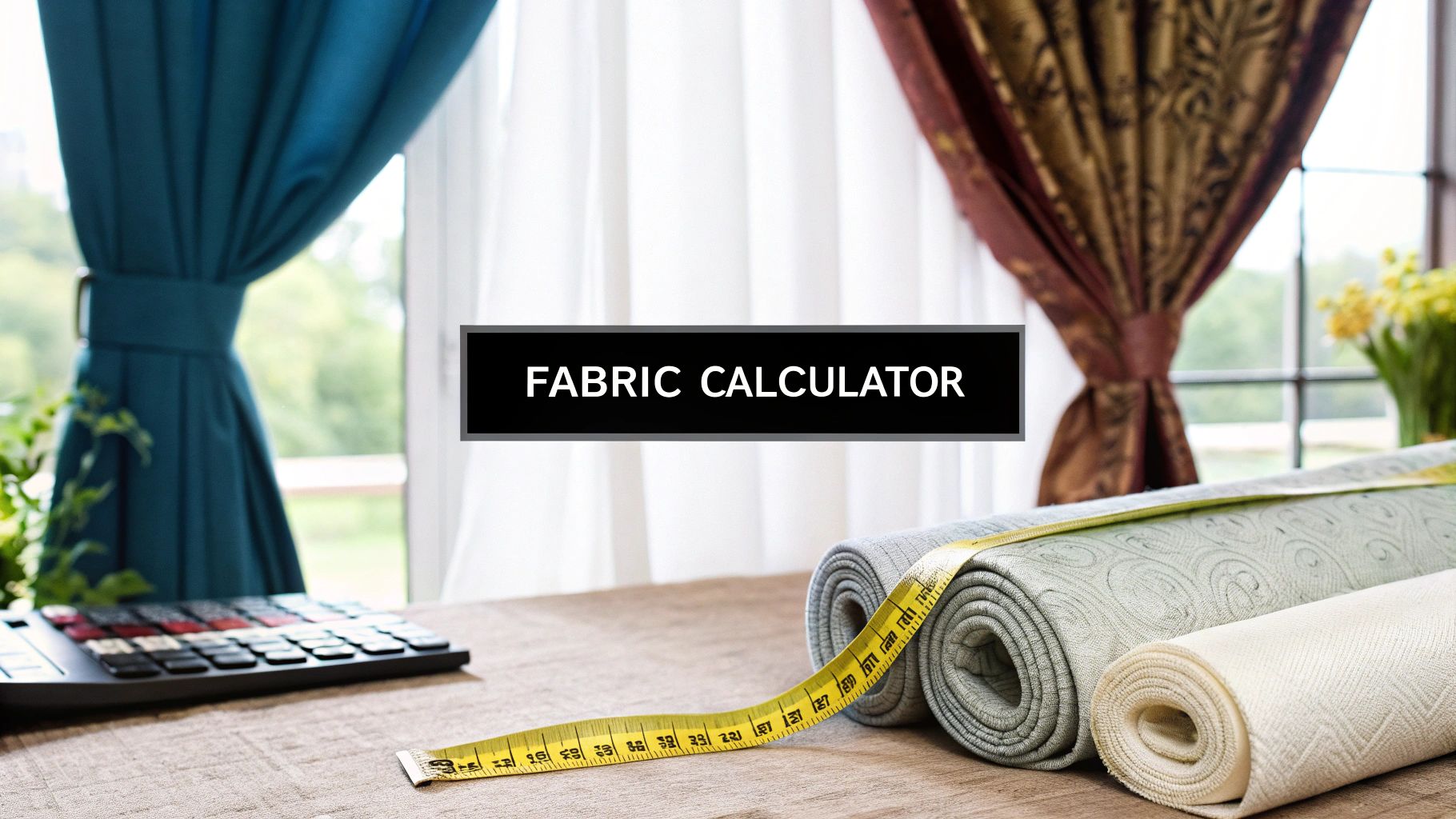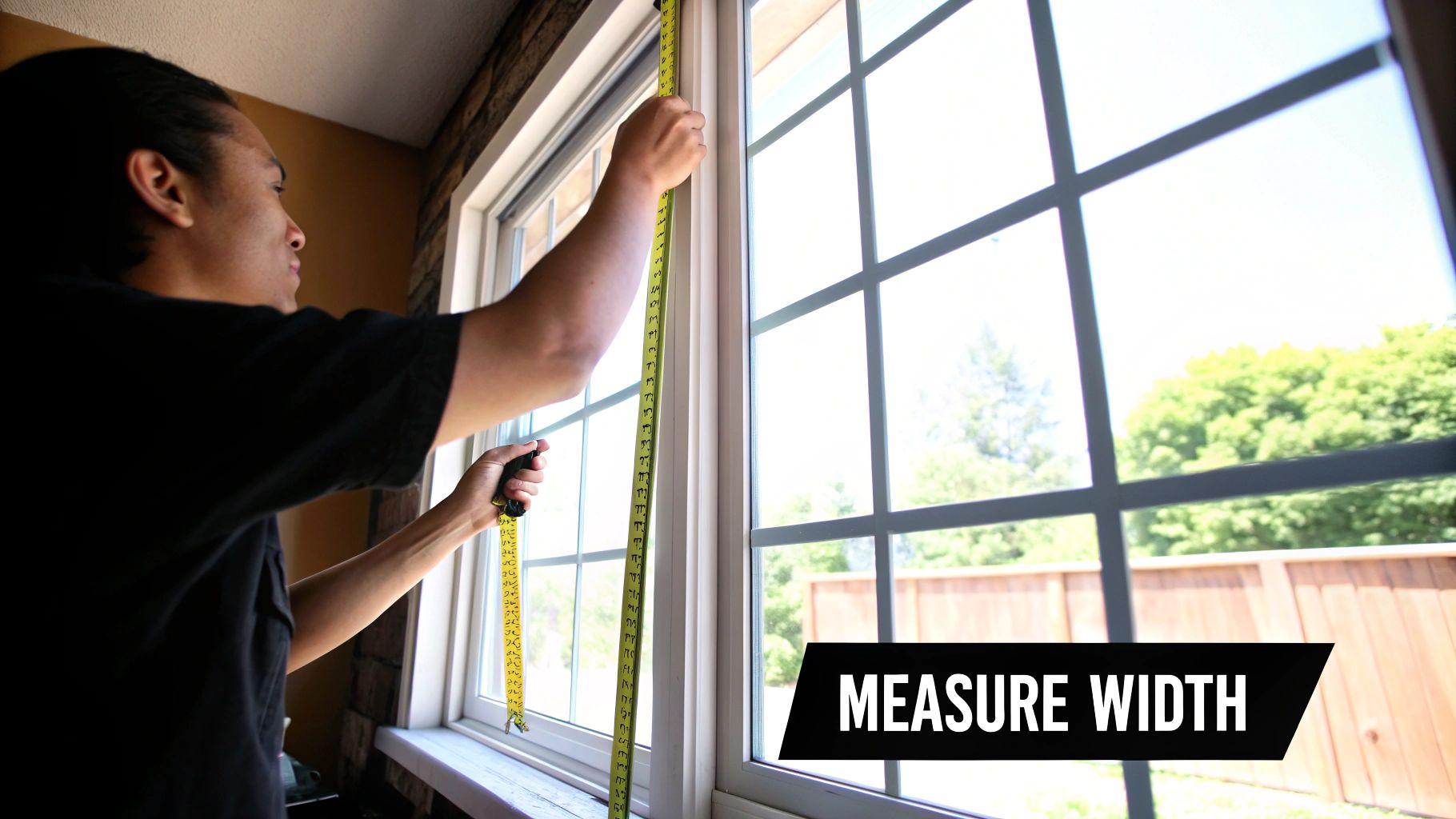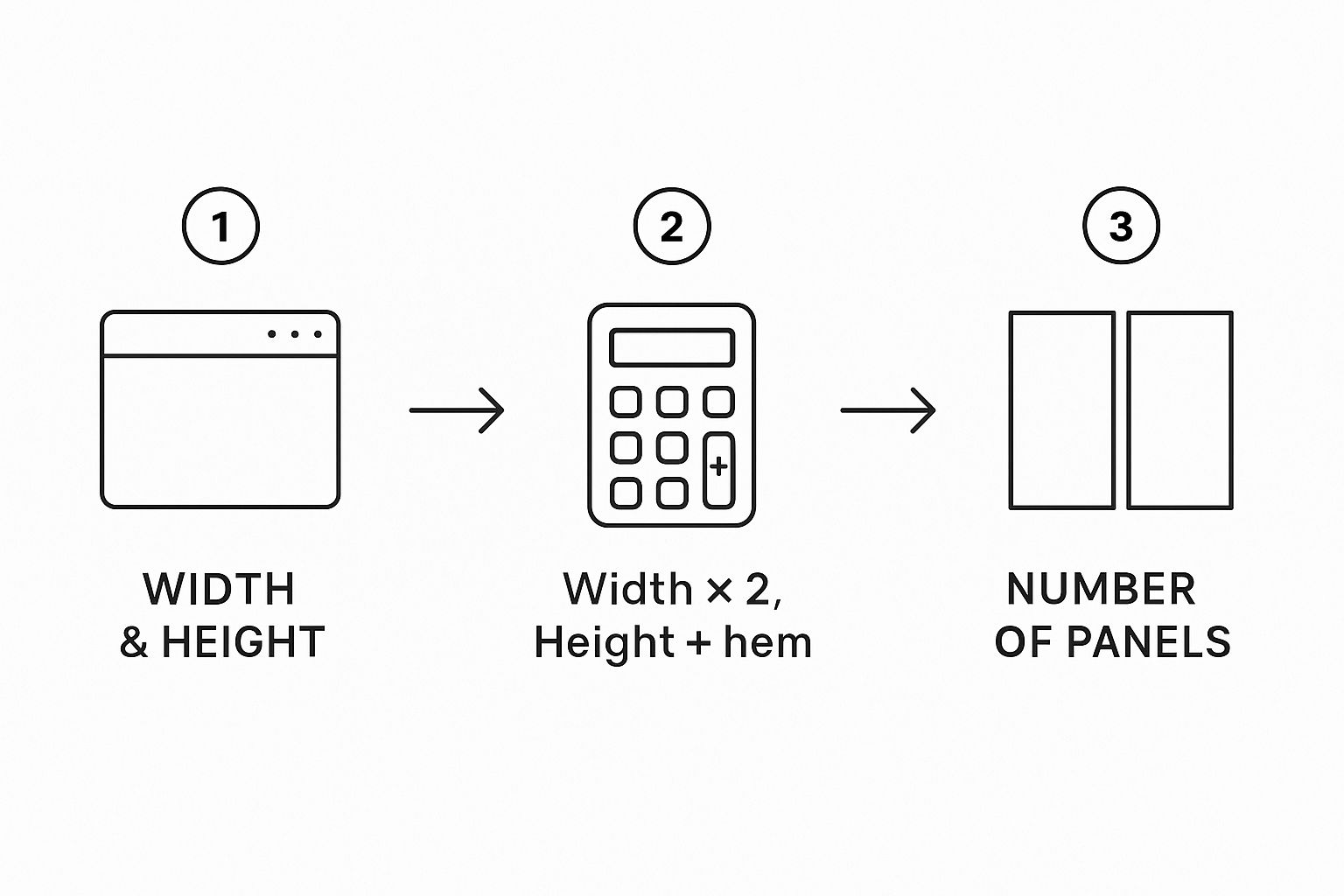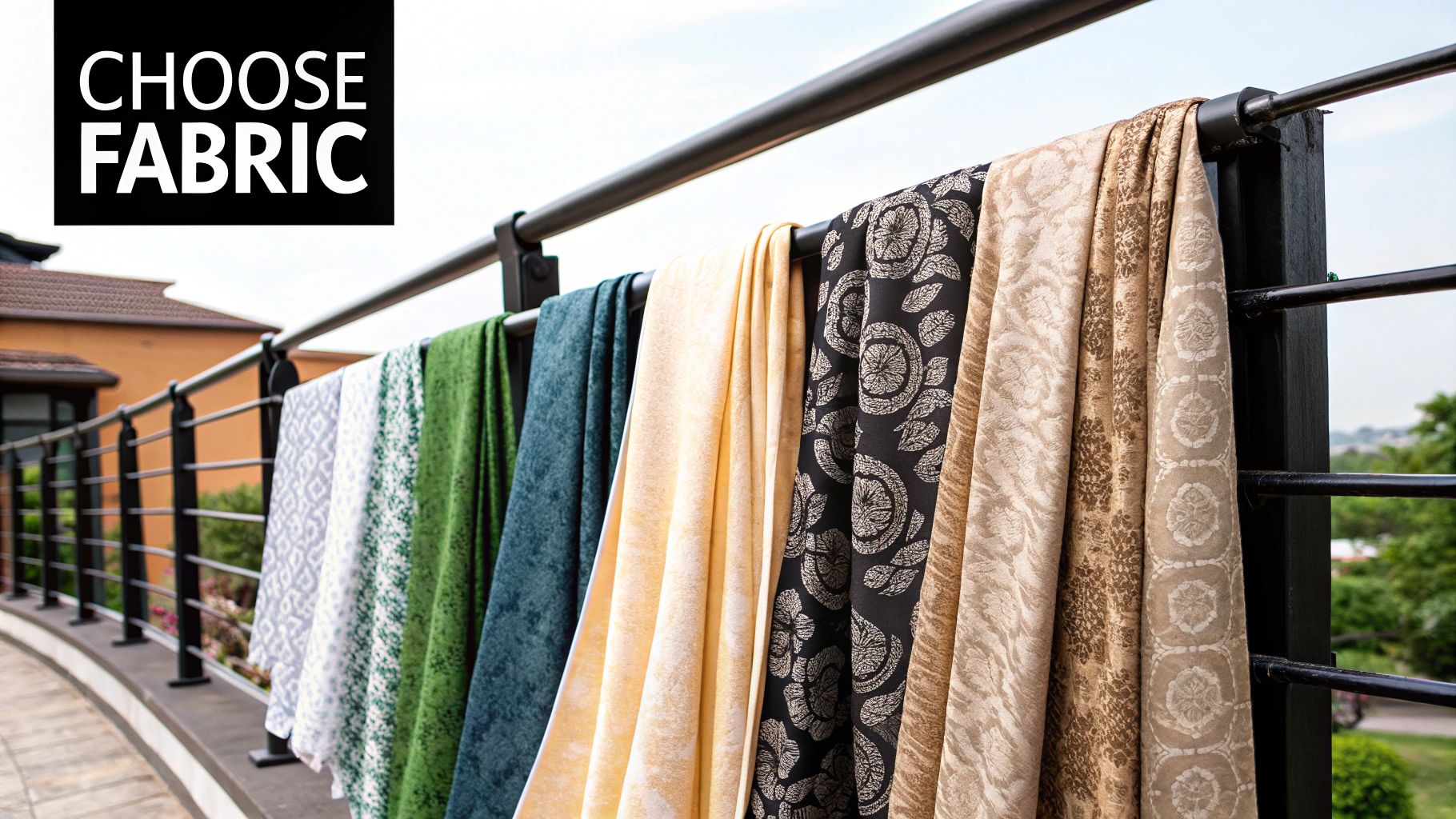Curtain Fabric Calculator – Easy Measurements & Savings

Why Precision Matters: The Power of Fabric Calculation
Let's face it – fabric mistakes are costly, especially for larger projects like curtains. A curtain fabric calculator takes the guesswork out of your New Zealand home projects, ensuring accuracy from the start. This not only saves you money but also helps achieve a professional, polished look that elevates your interiors.
Imagine spending hours selecting the perfect fabric, only to discover you're a meter short. This means another trip to the fabric store, hoping they still have it in stock. Or worse, settling for a mismatched piece that compromises your design. Accurate fabric calculation eliminates these frustrations.
The Cost of Errors and the Benefits of Accuracy
Many homeowners miscalculate their fabric needs, leading to last-minute store runs or disappointing results. This is particularly true for tricky window configurations like bay windows, a common feature in Kiwi homes, or floor-to-ceiling drapes. A precise curtain fabric calculator can be invaluable.
The growing demand for curtains and blinds, projected to hit US$84.98 million by 2025 in New Zealand, underscores the importance of getting it right. The market's steady growth of 1.21% annually, linked to home renovation trends, highlights the value Kiwis place on quality home decor, including curtain fabrics. Discover more insights about home decor trends
Measurement Secrets of the Pros
Professional interior designers in New Zealand understand the importance of precise measurements. They employ specific techniques for various window styles, ensuring perfect fits for any architectural feature. These techniques go beyond simply measuring width and height.
They factor in elements like stack-back space (the area curtains occupy when open), light gaps, and optimal hanging heights. This ensures your curtains not only look beautiful but also function perfectly, providing privacy and light control as intended. Understanding these nuances allows you to create truly bespoke window treatments that enhance the beauty and functionality of your home.
Mastering Measurements: The Foundation of Perfect Curtains

Accurate measurements are essential for perfect curtains. It's more than just width and height; understanding the nuances can transform ordinary curtains into stunning focal points. This is particularly true in New Zealand, where diverse architectural styles require a tailored approach.
Essential Measurements: More Than Just Width and Height
Think about stack-back space, the area your curtains occupy when open. Forgetting this can obscure your window, reducing natural light and creating a cramped feel. Light gaps around the edges can also compromise privacy and light control, especially in bedrooms or media rooms. How to master all the measurements for your curtains provides further helpful insights.
Heading Styles and Their Impact on Fabric Calculations
Your curtain heading style significantly affects fabric requirements. A simple pencil pleat needs less fabric than a luxurious pinch pleat or a contemporary wave fold. Each style creates a unique drape and fullness, changing the amount of fabric needed for the desired look. This could mean a difference of up to 50% in fabric for the same window.
Mastering Fullness Ratios
Fullness is the ratio of fabric width to window width. A higher ratio creates more gathers and a luxurious feel. A lower ratio offers a more tailored appearance. The right fullness depends on the fabric, desired look, and budget. Heavy fabrics like velvet often look best with a lower fullness (around 1.5-2 times the window width). Sheer fabrics benefit from a higher fullness (around 2.5-3 times).
Before we delve further into specific calculations, let's look at a helpful guide for various curtain styles:
Window Measurement Guide for Different Curtain Styles This table provides exact measurement requirements for various curtain styles commonly used in New Zealand homes.
| Curtain Style | Width Calculation | Length Calculation | Fullness Ratio | Special Considerations |
|---|---|---|---|---|
| Pencil Pleat | Window width x 1.5-2 | Measure from track/rod to desired length | 1.5-2 | Consider heading tape requirements when calculating length |
| Pinch Pleat | Window width x 2-2.5 | Measure from track/rod to desired length | 2-2.5 | Account for extra fabric needed for pleat creation |
| Wave Fold | Window width x 2-2.5 | Measure from track/rod to desired length | 2-2.5 | Ensure compatibility with wave fold track system |
| Eyelet | Window width x 1.5-2 | Measure from top of eyelet ring to desired length | 1.5-2 | Eyelet size affects overall length and look |
| Rod Pocket | Window width x 1.5-2 | Measure from top of rod to desired length | 1.5-2 | Ensure the rod diameter fits within the pocket |
This table provides a general guideline for various curtain styles. Remember to consult specific manufacturer instructions for precise calculations.
Tackling Tricky Kiwi Windows: Bay Windows and Beyond
Bay windows, common in New Zealand homes, present unique measurement challenges. These multi-angled windows need careful planning for a seamless fit. Corner windows and extra-wide openings also require special techniques. Accurate measuring and calculating fabric for these scenarios can transform awkward spaces into design highlights.
Precision for Pattern Matching
With patterned fabric, pattern matching is key for a professional look. This means aligning the pattern across multiple panels, adding complexity to calculations. The pattern repeat size (the distance before the pattern repeats) affects the fabric needed. Not accounting for this can lead to mismatches and wasted fabric. Precise measurements are crucial for a harmonious result.
Curtain Fabric Calculator: A Step-by-Step Masterclass
Transforming measurement anxiety into calculation confidence is key for successful curtain projects. This masterclass breaks down the formulas used by interior designers, revealing how each variable impacts your final fabric requirements. You'll learn how to navigate critical decisions, from fullness factors for different fabrics (like sheer voiles or heavy velvets) to pattern matching and heading adjustments.
Understanding the Basics: Width, Height, and Fullness
The foundation of any curtain fabric calculation lies in accurate window measurements. Start by measuring the width and height of your window. Simply multiplying these dimensions won't give you the correct fabric amount. You also need to consider fullness, which dictates the drape and richness of your curtains. Fullness is expressed as a ratio of fabric width to window width.
For example, a fullness of 2 means you'll need twice the width of your window in fabric. This ensures a pleasing drape and prevents the curtains from looking too flat.

As the infographic shows, accurate window dimensions are crucial. These initial measurements are the basis for calculating the number of fabric panels and the total fabric quantity. For a helpful guide on measuring, see: How to master measuring windows.
Navigating Fullness and Heading Styles
Choosing the right fullness depends on the fabric and desired aesthetic. Sheer fabrics often benefit from a higher fullness (around 2.5-3), creating a flowing, ethereal look. Heavier fabrics, like velvet, typically look best with a lower fullness (around 1.5-2), preventing a bulky appearance.
The heading style also significantly impacts fabric needs. A simple pencil pleat requires less fabric than a more gathered heading like a pinch pleat. This difference means that even with identical window dimensions and fullness, different heading styles will change the final calculations.
Factoring in Pattern Matching and Fabric Width
If you've chosen a patterned fabric, you'll need to account for pattern matching. This involves aligning the pattern across multiple panels, which requires extra fabric. The pattern repeat, the distance before the pattern repeats, is essential for these calculations.
Fabric width also plays a significant role. Standard fabric width is typically 137cm, but some fabrics come in wider widths, such as 280cm or 300cm. Using a wider fabric can reduce the number of panels needed, minimizing seams and simplifying installation. Accurate measurements are crucial for any home improvement project. For example, precise measurements are also vital when measuring kitchen cabinets.
The New Zealand curtains market saw a decrease of 9.2% in 2024, reaching a market size of about $12 million. More detailed statistics can be found here.
Mastering the Final Touches: Hems and Returns
Don't forget to include hem allowances. Allow at least 10cm for the bottom hem and 5cm for the top hem. Returns, the fabric extending from the curtain edge back to the wall, are essential for a polished look and preventing light bleed. These details can significantly impact the final fabric quantity.
This table helps estimate fabric requirements:
Fabric Requirements Calculator This calculator shows how much fabric you'll need based on different window dimensions and curtain styles
| Window Width (cm) | Window Height (cm) | Curtain Style | Fullness Factor | Required Fabric (m) |
|---|---|---|---|---|
| 100 | 150 | Pencil Pleat | 2 | 3 |
| 150 | 200 | Pinch Pleat | 2.5 | 7.5 |
| 200 | 250 | Grommet | 2 | 8 |
| 100 | 150 | Pencil Pleat | 1.5 | 2.25 |
| 150 | 200 | Pinch Pleat | 2 | 6 |
This table demonstrates how different window sizes, curtain styles, and fullness factors influence the total fabric needed. Remember to consider pattern repeats and hem allowances for a truly accurate estimate.
The Style Factor: Tailoring Calculations To Your Vision
Your curtain style significantly impacts how much fabric you'll need—sometimes by as much as 50%. This means choosing between a classic pencil pleat and a contemporary wave fold can drastically change your fabric purchase. Understanding these differences is essential for accurate calculations and avoiding costly errors.
Heading Styles and Their Impact On Fabric Quantity
Different heading styles create varying levels of fullness. Pinch pleats, a popular choice in New Zealand for their traditional elegance, require considerably more fabric than a sleek eyelet heading. This is because pinch pleats use extra material to create their distinctive gathered appearance. Similarly, wave fold headings, known for their modern, ripple-like design, have specific fullness requirements for optimal wave formation. Understanding these nuances is key to calculating your fabric needs correctly.
Fullness Factors: Finding The Right Balance
The fullness factor represents the ratio of fabric width to window width. A fullness factor of 2 means you'll need double your window's width in fabric. This factor directly affects the drape and overall look of your curtains. Too little fullness can lead to flat, unappealing curtains, while too much can look bulky and wasteful. Finding the right balance is crucial for achieving your desired aesthetic. You might be interested in: How to master choosing the right curtain fabric.
Regional Style Preferences Across New Zealand
Architectural styles vary across New Zealand, and so do curtain style preferences. In character homes, like villas, traditional heading styles such as pencil pleats or pinch pleats often complement the architecture. In modern builds, contemporary styles like wave folds or eyelet headings are more common. Understanding these regional preferences can help you choose a heading style that suits your home's overall design.
Matching Fabric and Style For Optimal Results
The weight and pattern of your chosen fabric also influence the best heading style and fullness factor. Heavier fabrics, like velvet, generally suit simpler heading styles and lower fullness ratios. Lighter fabrics, such as linen, can handle more complex headings and higher fullness. The global fabrics market, valued at approximately $139.36 billion in 2024 and projected to reach $152.69 billion by 2025, reflects the wide range of fabric options available. Find more detailed statistics here. This market growth highlights the importance of careful fabric selection and calculation for your projects. If you're also considering furniture dimensions, you might find this helpful: Chair Fit Calculator.
Achieving Your Design Vision Within Budget
By carefully considering heading style, fullness, and fabric characteristics, you can achieve your desired aesthetic and optimize your fabric investment. A precise curtain fabric calculator helps you avoid buying too much or too little fabric, ensuring you stay within budget while creating beautiful, functional window treatments. This allows you to bring your vision to life without overspending.
Pattern & Width: The Hidden Calculation Game-Changers

Beyond measuring your windows, the repeat of a pattern and the width of your fabric play a significant role in determining how much material you'll need for your curtains. These often-overlooked details can make the difference between a polished, cohesive look and a mismatched design. This section will help you understand these crucial elements, enabling you to confidently choose fabrics for your New Zealand home.
Decoding Pattern Repeats: A Key to Seamless Designs
For a harmonious look, understanding pattern repeats is essential. The pattern repeat refers to the vertical distance before the pattern starts over on the fabric. You'll typically find this measurement listed on the fabric bolt or within the online product description from New Zealand suppliers. For instance, a repeat of 30cm means the motif repeats every 30cm along the length of the fabric. Knowing this is crucial for calculating how much extra fabric you'll need to ensure the pattern aligns seamlessly across multiple curtain panels.
Vertical vs. Horizontal Repeats: Understanding the Difference
Most fabrics have a vertical repeat, where the pattern runs down the length of the material. Some fabrics, however, known as railroaded fabrics, feature a horizontal repeat. In this case, the pattern runs across the width. This difference significantly affects your calculations, particularly when matching patterns across multiple widths of fabric. Consider checking out our guide on sustainable linen choices for more information on selecting fabrics.
Fabric Width: Maximizing Your Meterage and Simplifying Installation
Fabric width generally ranges from 137cm (standard width) to 300cm (wide width). Opting for a wider fabric can drastically reduce the number of panels required for your curtains. This not only minimizes seams, creating a cleaner look, but also simplifies the installation process. A wider fabric might even allow you to use a single panel for a window, eliminating the need for pattern matching altogether.
Mastering Pattern Matching Across Multiple Curtain Widths
When working with patterned fabric for curtains wider than a single fabric width, precise calculations are essential. You'll need to add extra fabric to each panel to ensure the pattern aligns correctly. The amount of extra fabric will depend on the size of the pattern repeat. With complex patterns and larger repeats, the additional fabric can add up. However, the result – a seamlessly patterned, professional-looking drape – is worth the extra effort.
Handling Specialized Situations: One-Way Designs and Railroaded Fabrics
One-way designs introduce another level of complexity. These patterns have a designated top and bottom, meaning all panels must be cut in the same direction. This requires careful planning and may necessitate more fabric. Similarly, railroaded fabrics, with their horizontal repeats, require a different calculation approach, especially when matching patterns across widths. You'll need to consider both the horizontal and vertical repeats to ensure the design flows seamlessly across the entire curtain.
Calculating Precise Allowances for Complex Patterns
For intricate patterns with large repeats, accurate calculations are paramount. This involves dividing the pattern repeat by the number of panels and adding that amount to the fabric needed for each panel. This ensures proper alignment across all panels, avoiding any disruptive breaks in the pattern. While it involves some extra math, this precision guarantees a polished, professional finish.
Troubleshooting Your Curtain Fabric Calculator Journey

Even with the best planning, curtain projects can present challenges. This section addresses common calculation problems and offers practical solutions, drawing from experiences in New Zealand homes. We'll give you the tools to overcome these hurdles and achieve the perfect curtains for your space.
Non-Square Windows: Adapting to Character Homes
Many character homes in New Zealand, particularly older villas, have windows that aren't perfectly square. This can complicate accurate measurements. By carefully measuring each side and the diagonal, you can adapt your curtain fabric calculations.
For instance, if one side is slightly longer, adjust the width calculation to match. This ensures a proper fit and avoids gaps.
Sloped Ceilings: Recalculating for Unique Spaces
Sloped ceilings, common in attics or loft conversions, call for a different approach. Instead of a standard length measurement, measure at multiple points along the slope.
This allows you to calculate the right fabric amount, ensuring the curtains drape elegantly and don't bunch up on the floor. This method maximizes both aesthetics and function in these unique spaces.
Unusually Shaped Windows: Specialized Approaches
Unusually shaped windows, like arched or circular windows, require specialized techniques. These often involve custom-made curtains, and accurate calculations are essential to prevent costly errors.
Working with a professional curtain maker or using advanced curtain fabric calculator tools can simplify the process, ensuring a precise fit that complements the window's shape.
Challenging Fabrics: Managing Stretch and Shrinkage
Some fabrics, such as linen or silk, can stretch or shrink considerably, affecting the final dimensions. Linen, for example, can shrink up to 5% after washing.
To compensate, add extra fabric to your calculations – a professional tip that prevents disappointing outcomes. This ensures your curtains maintain their intended length and fullness after cleaning.
Limited Fabric Availability: Maximizing Remnants
Finding the ideal fabric only to discover limited stock can be frustrating. This is where creative solutions are needed. Consider using leftover fabric for smaller items like cushions or roman blinds.
Alternatively, if the fabric has an unusual width, recalculate your measurements to maximize the available material. This allows you to use your chosen fabric without compromising your design vision.
Curtain Relocations: Preserving Your Investment When Moving
Moving house is common for Kiwi families, and often, they want to keep their existing curtains. Recalculating for curtain relocations is vital. Measure the windows in your new home and compare them to your current curtain sizes.
Minor adjustments might be necessary for a good fit. This proactive step avoids unnecessary costs and lets you enjoy your curtains in your new home.
Ready to transform your home with beautiful, perfectly fitted curtains? Visit Maak Home today and explore our custom-made curtain fabrics and design services. Our team can help you create the perfect window treatments for your New Zealand home.









